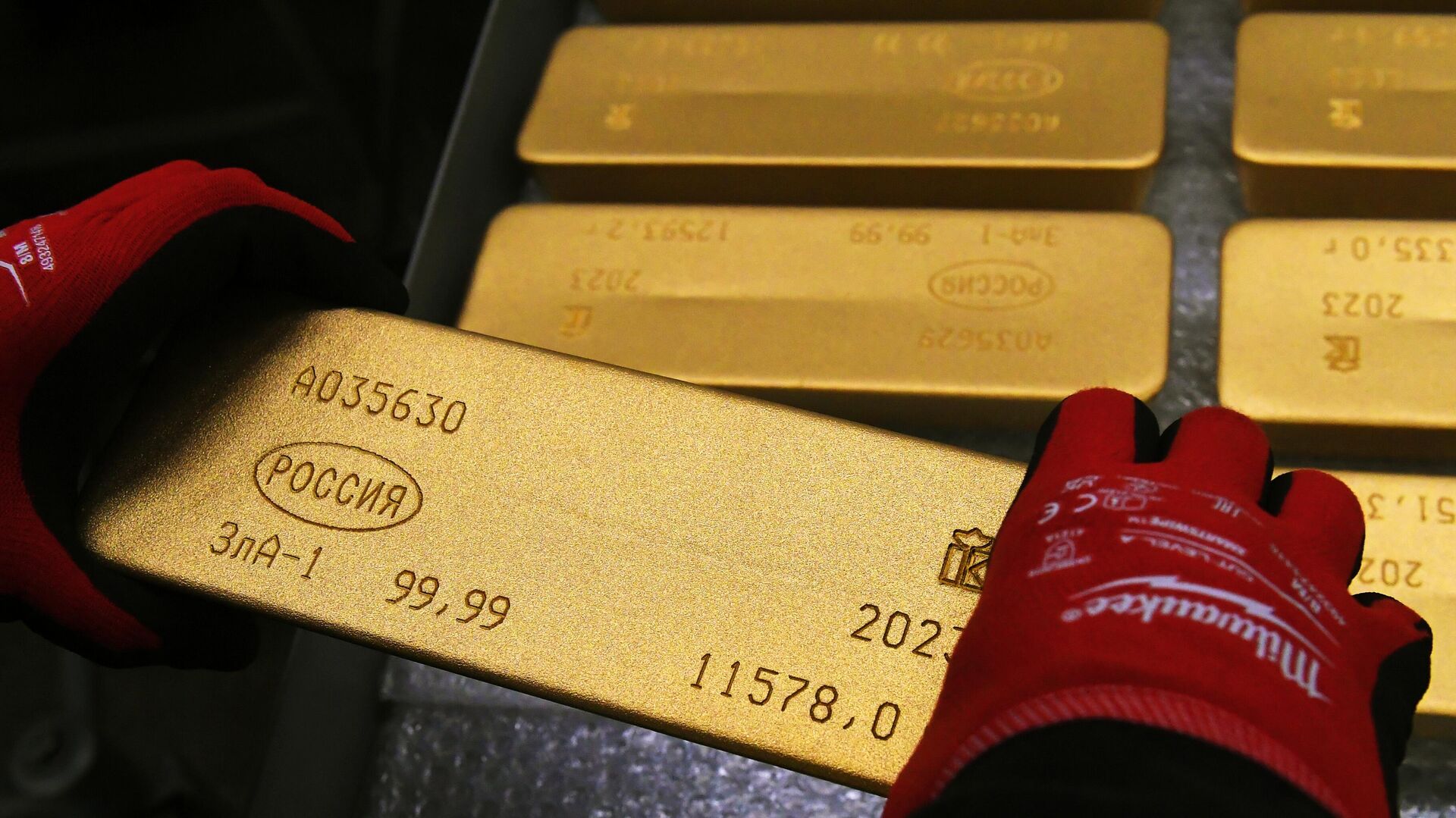https://sputnikglobe.com/20240920/gold-at-record-high-for-3rd-time-in-us-rate-cut-week-stalks-major-3000-target-1120224675.html
Gold At Record High for 3rd Time in US Rate Cut Week, Stalks Major $3,000 Target
Gold At Record High for 3rd Time in US Rate Cut Week, Stalks Major $3,000 Target
Sputnik International
NEW YORK (Sputnik) - Gold prices hit record highs Friday for a third time in a week as a hedge against a dollar battered by projected US interest rate cuts... 20.09.2024, Sputnik International
2024-09-20T14:17+0000
2024-09-20T14:17+0000
2024-09-20T14:17+0000
economy
lebanon
israel
us federal reserve
hezbollah
gold prices
gold production
gold
hamas
middle east
https://cdn1.img.sputnikglobe.com/img/07e8/01/10/1116195626_0:0:3642:2048_1920x0_80_0_0_9bdc97cf71cb63c01ac5ff63c242e809.jpg
At the time of writing, US gold futures for December delivery were slightly above $2,640 an ounce on the Comex division of the New York Mercantile Exchange, after peaking at $2,644.80 — rewriting prior record highs from Wednesday and Monday. The daily gain for December gold was about 1.1% while its weekly rise was around 1.2%, keeping it on a hot streak after last week’s 3.4% rally. Spot gold, which tracks real-time trades in gold bullion, hovered a little above $2,615 an ounce, after an all-time high at $2,619.36. For the session, spot gold rose 1.1%. For the week, it was up 1.5%. The Fed cut 50-basis points from US rates on Wednesday for the first time in four years, bringing the peak rate paid by Americans on their borrowings to 5% per annum from a previous two-decade high of 5.5%. Money market traders are betting there would be two more cuts of 25 basis points before the year-end to bring the peak for rates down to 4.5%. The dollar has been the biggest casualty from the action on rates, driving up gold, which typically rises as a contra trade for investors looking to hedge against the US currency’s drop. The Dollar Index, which pits the greenback against six major rival currencies, has fallen to 100.22 — a low not seen since the July 2023 bottom of 99.58. Many analysts think it’s a matter of “when” rather than “if” for the Dollar Index to break below the psychological 100 reading. Gold’s run-up this week also came amid heightened tensions in the Middle East after Lebanon blamed Israel for the widespread detonation of explosives planted in communication devices held by its Hezbollah operatives. Aside from being a hedge against the dollar, gold is also viewed as protection against political troubles that could weigh on the world economy. Lebanon has vowed retaliation as fighting in and around Gaza continued between the Palestinian Hamas operatives it supported and the Israel Defense Forces. With gold looking to take out by next week the near-term target of $2,700 an ounce envisaged by Wall Street bank Goldman Sachs, some analysts have set their sights on the major $3,000 price hurdle viewed as impossible by some just a year ago. Andrew Addison, a technical analyst for gold, wrote in the Barrons financial publication this week that gold had broken through various resistance to begin what he called “escape velocity” in the ramp toward $3,000. The technical analyst noted that from 2020 to 2023, the precious metal had formed a series of high-level consolidations, with each consolidation ending higher and shorter from the previous one — indicating less selling pressure at every major rally. Addison did caution of price corrections ahead in gold, but still asked investors to “consider all pullbacks as opportunities to buy or add to positions”. Gold’s run-up this year has made it one of the best-performing commodities of 2024, with both US futures and spot prices up more than 26%. In comparison, oil, represented by benchmark Brent crude, is down more than 3% on the year.
https://sputnikglobe.com/20240618/discover-the-worlds-top-gold-producers-for-2023--1119004775.html
lebanon
israel
Sputnik International
feedback@sputniknews.com
+74956456601
MIA „Rossiya Segodnya“
2024
Sputnik International
feedback@sputniknews.com
+74956456601
MIA „Rossiya Segodnya“
News
en_EN
Sputnik International
feedback@sputniknews.com
+74956456601
MIA „Rossiya Segodnya“
Sputnik International
feedback@sputniknews.com
+74956456601
MIA „Rossiya Segodnya“
lebanon, israel, us federal reserve, hezbollah, gold prices, gold production, gold, hamas, middle east
lebanon, israel, us federal reserve, hezbollah, gold prices, gold production, gold, hamas, middle east
Gold At Record High for 3rd Time in US Rate Cut Week, Stalks Major $3,000 Target
NEW YORK (Sputnik) - Gold prices hit record highs Friday for a third time in a week as a hedge against a dollar battered by projected US interest rate cuts, with analysts saying the major target of $3,000 an ounce was in view although several corrections were expected before that.
At the time of writing, US
gold futures for December delivery were slightly above $2,640 an ounce on the Comex division of the New York Mercantile Exchange, after peaking at $2,644.80 — rewriting prior record highs from Wednesday and Monday. The daily gain for December gold was about 1.1% while its weekly rise was around 1.2%, keeping it on a hot streak after last week’s 3.4% rally.
Spot gold, which tracks real-time trades in
gold bullion, hovered a little above $2,615 an ounce, after an all-time high at $2,619.36. For the session, spot gold rose 1.1%. For the week, it was up 1.5%.
“The precious metals bulls are reveling in the aftermath of an aggressive interest rate cut from the US Federal Reserve,” analyst Jim Wyckoff wrote on the website of bullion trader Kitco.
The Fed cut 50-basis points from US rates on Wednesday for the first time in four years, bringing the peak rate paid by Americans on their borrowings to 5% per annum from a previous two-decade high of 5.5%. Money market traders are betting there would be two more cuts of 25 basis points before the year-end to bring the peak for rates down to 4.5%.
The dollar has been the biggest casualty from the action on rates,
driving up gold, which typically rises as a contra trade for investors looking to hedge against the US currency’s drop. The Dollar Index, which pits the greenback against six major rival currencies, has fallen to 100.22 — a low not seen since the July 2023 bottom of 99.58. Many analysts think it’s a matter of “when” rather than “if” for the Dollar Index to break below the psychological 100 reading.
Gold’s run-up this week also came amid heightened tensions in the Middle East after Lebanon blamed Israel for the widespread detonation of explosives planted in communication devices held by its Hezbollah operatives.
Aside from being a hedge against the dollar, gold is also viewed as protection against political troubles that could weigh on the world economy. Lebanon has vowed retaliation as fighting in and around Gaza continued between the Palestinian Hamas operatives it supported and the Israel Defense Forces.
With gold looking to take out by next week the
near-term target of $2,700 an ounce envisaged by Wall Street bank Goldman Sachs, some analysts have set their sights on the major $3,000 price hurdle viewed as impossible by some just a year ago.
Andrew Addison, a technical analyst for gold, wrote in the Barrons financial publication this week that gold had broken through various resistance to begin what he called “escape velocity” in the ramp toward $3,000.
The technical analyst noted that from 2020 to 2023, the
precious metal had formed a series of high-level consolidations, with each consolidation ending higher and shorter from the previous one — indicating less selling pressure at every major rally.
Addison did caution of price corrections ahead in gold, but still asked investors to “consider all pullbacks as opportunities to buy or add to positions”.
Gold’s run-up this year has made it one of the
best-performing commodities of 2024, with both US futures and spot prices up more than 26%. In comparison, oil, represented by benchmark Brent crude, is down more than 3% on the year.



